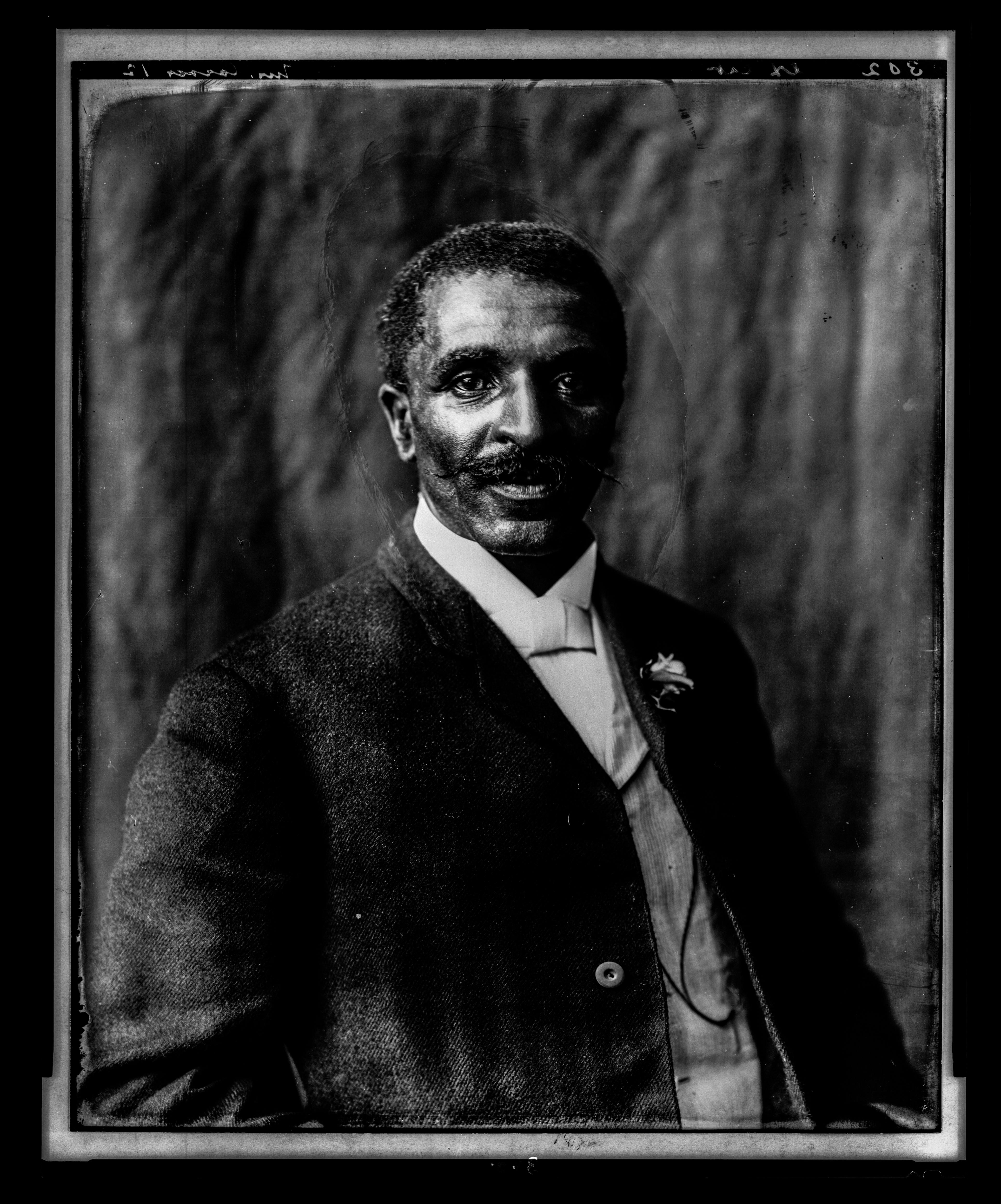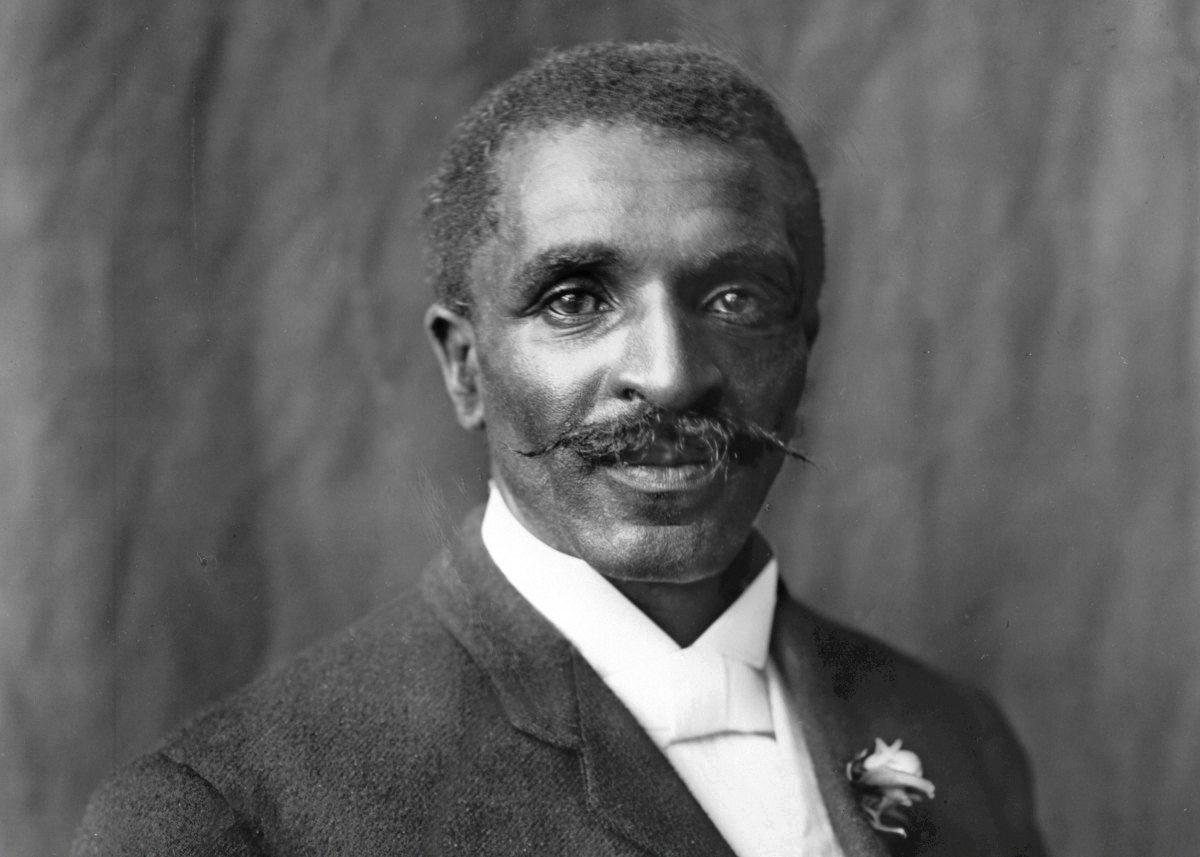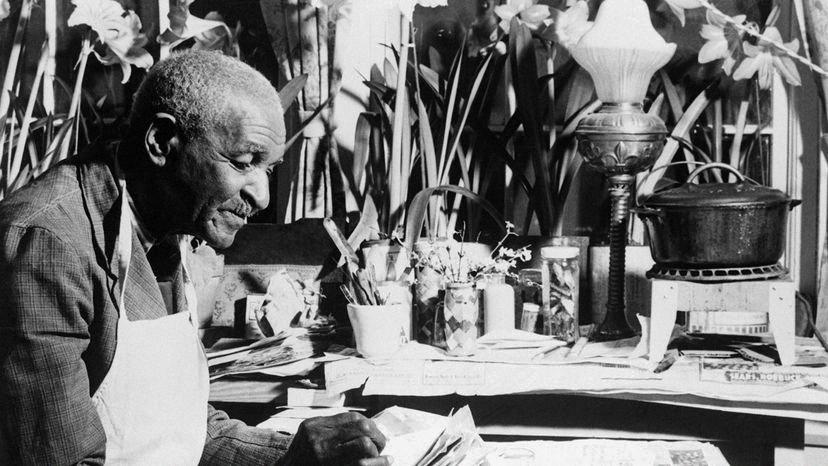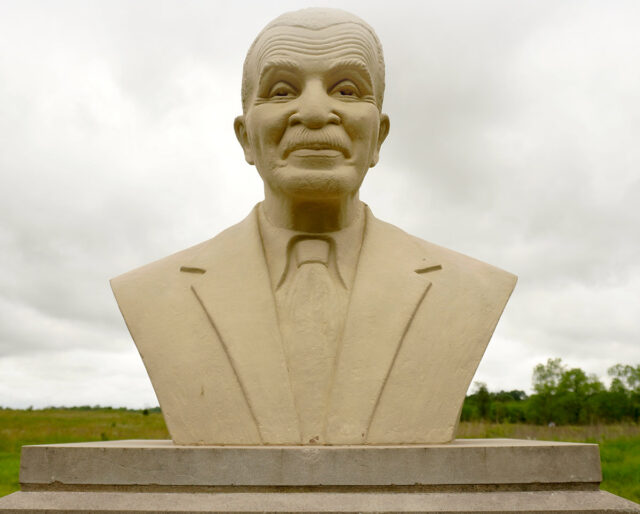George Washington Carver was an accomplished agricultural chemist, inventor, and educator. He dedicated his life to science and research, and his contributions to the field of agriculture have made a profound impact on the world. However, on January 5, 1943, Carver passed away at Tuskegee Institute after a fall down the stairs of his home. He was 78 years old at the time of his death.
Carver was born into slavery in Missouri in 1864, and he overcame incredible odds to become one of the most celebrated scientists in American history. He developed an interest in science at an early age, and he pursued his passion for learning despite the many obstacles he faced as a black man in the United States at that time.
In 1896, Carver left Iowa to take a job with Booker T. Washington at Tuskegee Institute in Alabama. There, he conducted agricultural research and taught students until his death. He was instrumental in developing new farming techniques and promoting the use of alternative crops like peanuts and sweet potatoes.
Contrary to popular belief, Carver did not invent peanut butter. However, he did discover over 300 uses for peanuts, including chili sauce, shampoo, shaving cream, and glue. He was a tireless researcher and inventor, and his legacy continues to inspire scientists and innovators today.
Carver nver married, but he did have a three-year courtship with Sarah L. Hunt, an elementary school teacher and the sister-in-law of Warren Logan, Treasurer of Tuskegee Institute. Unfortunately, the relationship ended when Hunt took a teaching job in California.
George Washington Carver was an extraordinary individual who dedicated his life to science, research, and education. His contributions to the field of agriculture continue to impact the world today, and his legacy as a pioneering scientist and inventor will live on for generations to come.
The Death of George Washington Carver
George Washington Carver died on January 5, 1943, at the age of 78. He died at Tuskegee Institute, where he had spent most of his career as a professor and researcher. The cause of his death was a fall down the stairs of his home. The fall resulted in a broken hip, which ultimately led to his death.
Carver was buried on the grounds of Tuskegee Institute, next to his close friend and mentor, Booker T. Washington. Carver’s death was a great loss to the scientific community, as well as to the African American community, who saw him as a trailblazer and role model.
During his lifetime, Carver had made significant contributions to the field of agriculture, particularly in the study of peanuts and sweet potatoes. He had also become a prominent figure in the civil rights movement, working to improve the lives of African Americans trough education and innovation.
George Washington Carver died as a result of a fall down the stairs of his home, which led to a broken hip and ultimately, his death. He was buried on the grounds of Tuskegee Institute, where he had spent most of his career as a professor and researcher. His death was a great loss to the scientific and African American communities, but his legacy lives on through his many contributions to agriculture and civil rights.

Source: darcymaulsby.com
Did George Washington Carver Have a Spouse?
George Washington Carver never got married during his lifetime. Despite being a renowned scientist and inventor, he never found a life partner to share his achievements with. At the age of 40, he started a courtship with Sarah L. Hunt, who worked as an elementary school teacher. Sarah was the sister-in-law of Warren Logan, the Treasurer of Tuskegee Institute, were Carver worked. The courtship lasted for three years, but Sarah eventually took a teaching job in California, and their relationship came to an end.
Carver’s focus on his work and research may have contributed to his decision not to get married. He dedicated most of his life to his passion for science and agriculture, leaving little time for personal relationships. Nonetheless, his contributions to the field of science and his legacy continue to inspire generations of people worldwide.
George Washington Carver’s Accomplishments Before His Death
George Washington Carver was a renowned agricultural chemist who made significant contributions to the field of agriculture. Before his death, he spent most of his life conducting research and teaching at Tuskegee Institute in Alabama. He was hired by Booker T. Washington in 1896, and he worked there until his death.
During his time at Tuskegee Institute, Carver conducted extensive research on agriculture, particuarly on crops that were important to the Southern economy, such as peanuts, sweet potatoes, and cotton. He discovered various uses for these crops, including developing new products, such as peanut butter, and finding ways to improve soil fertility and prevent soil depletion.
In addition to his research, Carver was also a dedicated teacher. He taught courses in agricultural science and conducted workshops for farmers, sharing his knowledge and expertise with his students and the wider community. His work had a significant impact on agriculture in the United States, and he is remembered as one of the most influential scientists of his time.
Carver passed away on January 5, 1943, at the age of 78. Despite his passing, his legacy lives on, and his contributions to the field of agriculture continue to inspire and inform scientists and farmers alike.
Did George Washington Carver Invent Peanut Butter?
Despite the widespread belief that George Washington Carver invented peanut butter, this is not accurate. While Carver was a renowned inventor and botanist who made significant contributions to the study of peanuts, he did not invent peanut butter as we know it today.
It is widely believed that peanut butter was frst invented by a St. Louis physician named Dr. Ambrose Straub in 1895. However, the process of grinding peanuts into a paste-like substance had been done for centuries in South America, Africa, and Asia.
That being said, Carver did play a significant role in promoting the use of peanuts in American agriculture and industry. He discovered and promoted over 300 uses for peanuts, including peanut oil, peanut milk, peanut flour, and roasted peanuts. Some of his other peanut-based inventions included chili sauce, shampoo, shaving cream, and glue.
Carver’s work on peanuts helped to diversify the crops grown by American farmers and promote sustainable agriculture practices. His legacy continues to inspire researchers and innovators in the fields of botany and agricultural science today.
While George Washington Carver did not invent peanut butter, he was a pioneering inventor and botanist who made significant contributions to the study and use of peanuts in American agriculture and industry.
The Discovery of Edible Peanuts
The discovery of peanuts as an edible food source is not attributed to a single individual. However, it is believed that the indigenous people of South America were the fist to cultivate and consume peanuts as early as 3,500 years ago. The peanut plant is native to South America, specifically to Bolivia, Brazil, and Peru.
The plant was introduced to Africa by European traders in the 16th century, where it quickly became a popular crop due to its ability to grow in hot and dry climates. Africans were the first to introduce peanuts to North America beginning in the 1700s.
It wasn’t until the early 1800s that peanuts were grown as a commercial crop in the U.S. They were first grown in Virginia and used mainly for oil, food and as a cocoa substitute. As the popularity of peanuts grew, so did the demand for peanut butter. In 1895, Dr. John Harvey Kellogg (of Kellogg’s cereal fame) patented the process of making peanut butter, which helped to make peanuts an even more popular food source.
While there is no one person credited with discovering peanuts as an edible food source, it was the indigenous people of South America who first cultivated and consumed them. It was then the Africans who introduced peanuts to North America, and it wasn’t until the early 1800s that peanuts were grown commercially in the U.S.

Source: treehugger.com
George Washington Carver: The Peanut Man
George Washington Carver, a renowned African American scientist, was famously referred to as the “Peanut Man” due to his extensive research and experimentation with peanuts. Although he did not invent peanut butter, as is commonly believed, Carver dedicated his life to exploring the many potential uses of peanuts.
In 1920, Carver delivered a speech before the Peanut Growers Association, highlighting the numerous benefits and applications of peanuts beyond simply being a food source. He emphasized that peanuts coud serve as a source of oil, animal feed, and even medicine. His research also led to the development of new peanut-based products such as cosmetics and dyes.
Carver’s work with peanuts was groundbreaking and earned him widespread recognition as an expert in the field. His contributions to the study of agriculture and his advocacy for crop diversification continue to inspire scientists and farmers today.
Height of George Washington Carver
George Washington Carver was a renowned African American scientist, inventor, and educator who lived in the late 19th and early 20th centuries. According to historical records, Carver was nearly six feet tall, which is equivalent to approximately 183 centimeters or 1.83 meters. This information is based on his high school graduation record from Minneapolis, Kansas in the spring of 1885, indicating that he was alreay nearly six feet tall at that time.
Carver’s height was significant not only because it made him stand out physically, but also because it may have influenced his life and career in various ways. For instance, being tall could have given him a sense of confidence and authority, which could have helped him to succeed in his academic pursuits and later as a teacher and researcher. Moreover, Carver’s height might have made him more visible and memorable to others, which could have helped him to network and gain recognition for his work.
While George Washington Carver’s height may seem like a minor detail, it is an interesting and noteworthy aspect of his life that sheds light on his physical appearance and potential impact on his career.
The Fate of George Washington Carver After His Kidnapping
After George Washington Carver was kidnapped during the American Civil War, he and his mother were taken to Arkansas to be sold. Fortunately, Moses Carver, the man who ownd the farm where they were living before the kidnapping, was able to track George down and bring him back home. However, Mary, George’s mother, was never found and it is believed that she died in Arkansas.
After his return, George was raised by the Carvers and became an incredibly bright student. He attended several schools, including Simpson College in Iowa and Iowa State Agricultural College, where he studied botany and agriculture. George eventually became a renowned scientist and inventor, known for his work with peanuts and sweet potatoes.
Some of George Washington Carver’s most notable achievements include:
– Developing hundreds of new uses for peanuts, including peanut butter, shampoo, and ink.
– Promoting crop rotation and soil conservation, which helped farmers improve their yields and preserve the land.
– Developing new techniques for growing and processing sweet potatoes, which helped make them a more popular and profitable crop.
Throughout his life, George Washington Carver remained dedicated to improving the lives of farmers and promoting sustainable agriculture. He passed away in 1943 at the age of 78.
The Famous Quote of George Washington Carver
George Washington Carver is a renowned American scientist and inventor who made significant contributions in the field of agriculture. He is famous for his groundbreaking research on peanuts, sweet potatoes, and oher crops that helped revolutionize farming practices in the southern United States.
One of his most famous quotes is, “When you do the common things in life in an uncommon way, you will command the attention of the world.” This quote is often interpreted as a call to think outside the box and to approach tasks with creativity and innovation.
Carver’s work focused on improving the lives of farmers and promoting sustainable farming practices. He believed that by finding new and innovative ways to use crops like peanuts and sweet potatoes, farmers could improve their yields and provide greater economic stability for themselves and their communities.
Throughout his career, Carver was dedicated to promoting education and scientific research, particularly among African American communities. He believed that knowledge was a powerful tool for social and economic advancement, and he worked tirelessly to promote education and scientific research throughout his life.
George Washington Carver’s famous quote is “When you do the common things in life in an uncommon way, you will command the attention of the world.” This quote reflects his commitment to innovation, creativity, and scientific research, and it continues to inspire people around the world to approach challenges with a spirit of innovation and determination.

Source: science.howstuffworks.com
The Kidnapping of George Washington Carver
George Washington Carver was a renowned African American scientist and inventor, who made significant contributions in the field of botany and agriculture. However, his life wasn’t always smooth sailing. George was born into slavery in Missouri, in the early 1860s, during the Civil War era.
George and his mother and sister were kidnapped by slave raiders, who planned to sell them as slaves. The kidnappers were ruthless and had no regard for human life, treating people as commodities to be bought and sold.
The reason for the kidnapping of George and his family was purely financial gain. Slave raiders made a living by capturing and selling slaves, who were forced to work on plantations or as domestic servants. The slave trade was a lucrative business, and many people were willing to pay a high price for slaves.
Moses Carver, a German immigrant, found George after he was kidnapped, but unfortunately, his mother and sister were not found. It was a common practice during those times for slave raiders to separate families and sell them to different owners. This was a cruel practice that caused immense pain and suffering to families who were torn apart.
After the abolition of slavery, George was raised by Moses Carver and his wife, who provided him with an education and an opportunity to pursue his interests in science and agriculture. George went on to become one of the most celebrated scientists of his time, leaving a lasting legacy that continues to inspire people around the world.
George Washington Carver was kidnapped by slave raiders who sought to profit from the slave trade. The practice of separating families and selling them to different owners was common during those times, and unfortunately, George’s mother and sister were not found. Despite facing immense hardship, George went on to achieve great thngs in his life, becoming an inspiration to people all over the world.
Inventions of George Washington Carver Without Peanuts
Although George Washington Carver is widely known for his work with peanuts, he also made significant contributions in other fields. Among his inventions were several products derived from soybeans.
Carver invented a process for producing paints and stains from soybeans, for which he was granted three different patents. This process involved using soybean oil as a base for the paints and stains, which provided a durable and eco-friendly alternative to traditional petroleum-based products.
In addition to soybean-based paints and stains, Carver also developed a wide range of other products from soybeans, such as adhesives, plastics, and even synthetic rubber. These inventions helped to promote the use of soybeans as a versatile and sustainable crop, with a wide range of industrial applications.
Carver’s work with soybeans was just one example of his innovative spirit and commitment to sustainable agriculture. Through his research and inventions, he demonstrated the potential for agriculture to be both profitable and environmentally friendly.
The Invention of Peanut Butter
Contrary to popular belief, peanut butter was not invented by a single state in the US. However, the history of peanut butter can be traced back to the late 1800s in Canada and the United States.
Marcellus Gilmore Edson, a Canadian chemist, is credited with obtaining the first patent for a method of producing peanut butter in 1884. He used heated surfaces to grind roasted peanuts into a paste, whch was then cooled and stabilized.
In the United States, Dr. John Harvey Kellogg, a physician and health food enthusiast, also experimented with peanut butter in the late 1800s. He created a peanut butter paste for his patients who had difficulty chewing solid food.
However, it was George Washington Carver, an African American scientist and inventor, who popularized peanut butter in the United States. Carver developed hundreds of uses for peanuts, including peanut butter, and promoted them as a nutritious and versatile food source.
Today, peanut butter is a staple in many American households and is enjoyed in a variety of ways, from sandwiches to baked goods to sauces and dips.
Exploring the Inventor of 100 Ways to Use a Peanut
George Washington Carver is kown for discovering over 300 uses for peanuts, not just 100. He was a renowned inventor and scientist who dedicated his life to researching and promoting the use of peanuts and other crops.
Born into slavery in Missouri in the 1860s, Carver overcame numerous obstacles to become one of the most respected scientists of his time. He earned a degree in agriculture from Iowa State University and eventually became the director of the Agricultural Experiment Station at the Tuskegee Institute in Alabama.
Carver’s research into peanuts and other crops revolutionized agriculture and industry in the United States. His work led to the development of new products such as peanut butter, peanut oil, and peanut milk. He also discovered new uses for peanuts in medicine, cosmetics, and even as a substitute for gasoline.
In addition to his work with peanuts, Carver also researched and promoted other crops such as sweet potatoes, soybeans, and pecans. He believed that these crops could help improve the lives of farmers and bring economic prosperity to the South.
Carver’s legacy lives on today through the many products and industries that use peanuts and other crops that he helped to promote. His dedication to scientific research and his commitment to improving the lives of others make him one of the most important inventors in American history.

300 Uses of Peanuts
George Washington Carver, a renowned agricultural scientist, inventor and educator, conducted extensive research on peanuts during his time at Tuskegee Institute in Alabama. Through his work, he discovered over 300 uses for peanuts, which he turned into various products. Here are some of the products that he developed:
– Peanut flour: This was made by grinding roasted peanuts into a fine powder. It culd be used as a substitute for wheat flour in baking, or added to smoothies for extra protein.
– Peanut paste: This was made by grinding roasted peanuts into a thick paste. It could be used as a spread, similar to peanut butter, or added to sauces and marinades.
– Insulation: Carver discovered that peanut shells were a great insulator, so he used them to create insulation for homes and other buildings.
– Paper: Peanut shells and stalks could be used to make paper. Carver developed a process for breaking down the materials and turning them into pulp, which could then be pressed into sheets of paper.
– Wall board: Similar to insulation, Carver discovered that peanut shells could be used to make wall board for homes and buildings.
– Wood stains: Carver developed a range of wood stains using peanuts. He found that the oils in peanuts could be used to create a variety of shades and colors.
– Soap: Peanut oil was used to make soap, which was particularly useful for people with sensitive skin.
– Shaving cream: Carver developed a shaving cream made from peanut oil and other natural ingredients.
– Skin lotion: Peanut oil was also used to make skin lotion, which was believed to help with dry and cracked skin.
Carver also experimented with using peanuts to create medicines. He developed antiseptics, laxatives, and a treatment for goiter, all made from peanuts.
Carver’s work with peanuts was groundbreaking, and his discoveries continue to impact the way we use and consume peanuts today.
Conclusion
George Washington Carver was an incredibly innovative and influential figure in American history. His dedication to agricultural research revolutionized the farming industry and helped provide solutions to the problems faced by farmers at the time. Carver’s discovery of over 300 uses for peanuts alone demonstrates his creative genius and his commitment to finding practical applications for scientific knowledge.
Beyond his scientific contributions, Carver was also an inspiration to countless individuals. As a black man in the late 19th and early 20th century, he faced significant obstacles in his pursuit of education and professional success. Nevertheless, he persevered and becme a respected member of the academic community, earning the admiration of many.
Carver’s legacy continues to inspire people today, and his contributions to science and society are still celebrated. He serves as a reminder that with hard work, perseverance, and an unwavering commitment to excellence, anything is possible.
